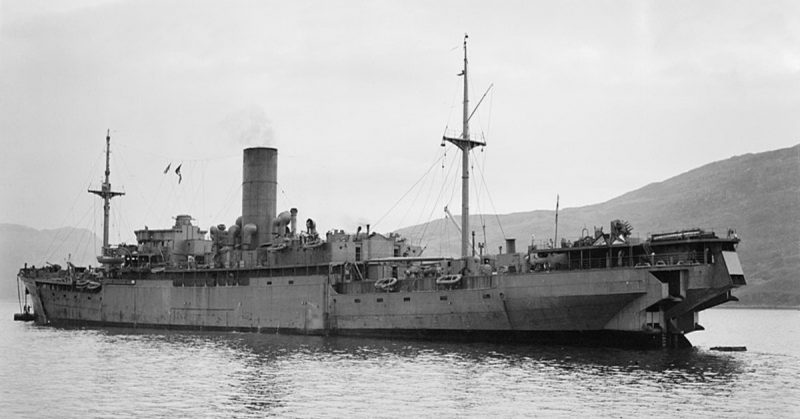What better way to keep a soldier at his best than to keep him happy?
In 1933, the 21st Amendment saw America out of Prohibition and brought the legal sale of alcohol back to the country. Less than a decade later, the country was pulled into the grips of World War II and found itself fighting side-by-side with an ally who had quite different ideas about drinking.
Though American marketing and industry nomenclature sing the praises of German- and Belgian-style beer, Great Britain has maintained a strong brewing culture since before the Romans arrived on the British Isles in 54 BCE.
Over the centuries, the industry continued to grow. There’s hardly a village in England, Scotland, or Ireland where there’s not at least one pub (or two, or three). The beer industry went on alert during the First World War, a time when temperance movements were rife across the globe. Fortunately for British brewers, such movements were not as successful as those in America.
Taxes began to affect the percentage of ABV (alcohol by volume), and there was a concern that drinking wouldn’t be the same, but luckily the good ‘ole days prevailed and the British maintained one of their favorite past times. Beer production continued and found itself intertwined in unexpected industries.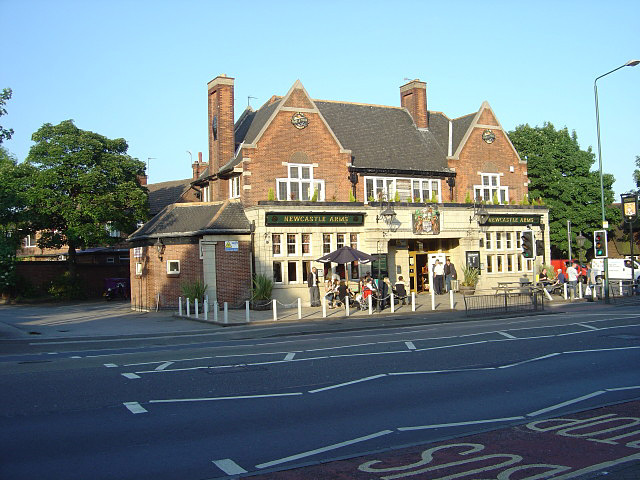 Newcastle Arms. The name is derived from the Duke of Newcastle who owned most of the coal concessions in the area. Photo: Alan Murray-Rust CC BY-SA 2.0
Newcastle Arms. The name is derived from the Duke of Newcastle who owned most of the coal concessions in the area. Photo: Alan Murray-Rust CC BY-SA 2.0
Normally, when told of “military spending,” one doesn’t think beer would be included in the budget. The Royal Fleet Auxiliary service of the British Army from the mid-twentieth century would beg to differ.
During World War II, the British envisaged being in a long war. They needed their troops to be kept at their fighting best. What better way to keep a soldier at his best than to keep him happy? That’s where the HMS Menestheus came into the picture.
Having completed its last mission in October 1943, the minelaying ocean liner, the HMS Menestheus, retired from active service. On the west coast of Canada, the ship was repurposed. Changing from ominous battle gray, it was repainted white and outfitted to be an “amenity ship,” complete with movie theatre, canteen, and brewery.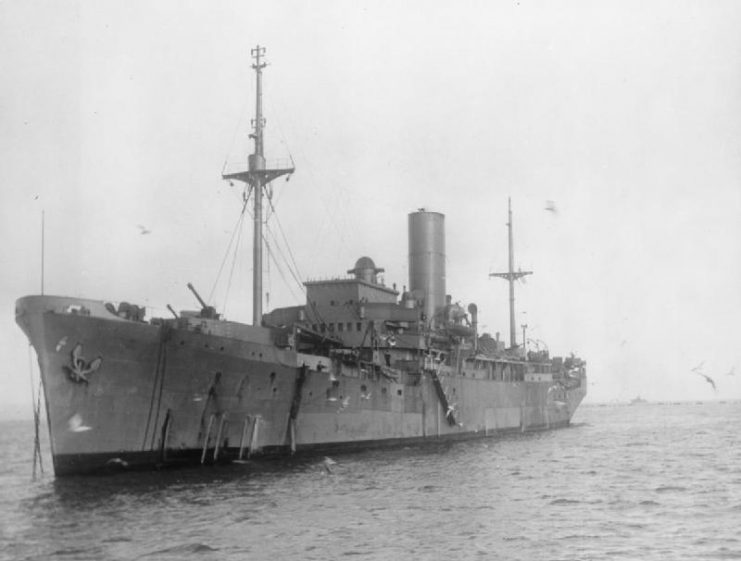 HMS Menestheus At anchor.
HMS Menestheus At anchor.
Shelf-life and conservation were very different at this time. Beer from home could find its way to a soldier in the Pacific Ocean, but it certainly didn’t taste like home. Any attempts to import beer to the troops produced pretty nasty results. Furthermore, at this time, the beer industry was undeveloped in Asia and unable to meet the British soldiers’ needs.
Therefore, the Menestheus was fully kitted out to be a floating brewery ready to make house calls across the Pacific.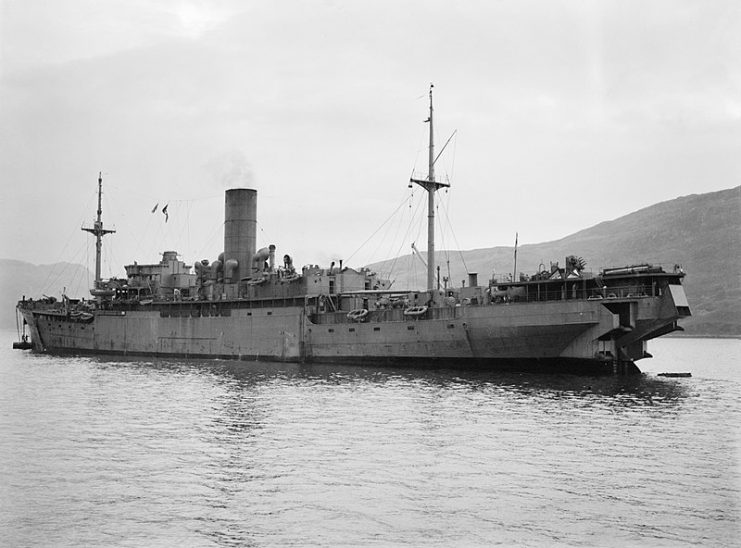 The auxiliary minelayer HMS MENESTHEUS, a converted Mercantile ship moored at a minelaying base on the Kyle of Lochalsh.
The auxiliary minelayer HMS MENESTHEUS, a converted Mercantile ship moored at a minelaying base on the Kyle of Lochalsh.
George Brown from the famous Truman’s Brewery (active from the 17th century until its downfall in the 1980s) of London was made head brewer. He produced the ship’s first batch of beer on New Year’s Eve 1945. Needing only eight days to ferment and settle, the second batch was on the go by January 7th, 1946.
Though the ship wasn’t outfitted to be working while in motion, when it was stationary the Menestheus was able to pump out 250 British-sized (or 350 American-sized) barrels per week.
Using the heat that came from the ship’s boilers themselves, distilled sea water, and malt extract, Brown further defied the odds of brewing in such an unusual location by using a closed-fermentation system which was developed to make up for the lack of a mash tun. Relative sizes of English wine cask units, prior to 1824. The tun=252 gallons; pipe=126 gallons; tercian=84 gallons; hogshead=63 gallons; tierce=42 gallons; barrel=31.5 gallons; rundlet=18 gallons.Photo: Grolltech CC BY-SA 3.0
Relative sizes of English wine cask units, prior to 1824. The tun=252 gallons; pipe=126 gallons; tercian=84 gallons; hogshead=63 gallons; tierce=42 gallons; barrel=31.5 gallons; rundlet=18 gallons.Photo: Grolltech CC BY-SA 3.0
The ship had a singular signature brew: an English Mild at about 3.7% ABV.
The Menestheus was not just meant to supply the soldiers who were able to access the ship directly, but it also had to provide beer that could be distributed to troops among other ships and bases.
Another ship, the HMS Agamemnon, was undergoing equal outfitting but remained unfinished when hostilities with Japan ended. With no war, the British army’s plan for an eventual ten repurposed brew ships had to be abandoned.
Even though the war was over, British troops were still stationed overseas through 1946 and in need of refreshment. The Menestheus would go on to travel to Yokohama, Kure, Shanghai, and Hong Kong.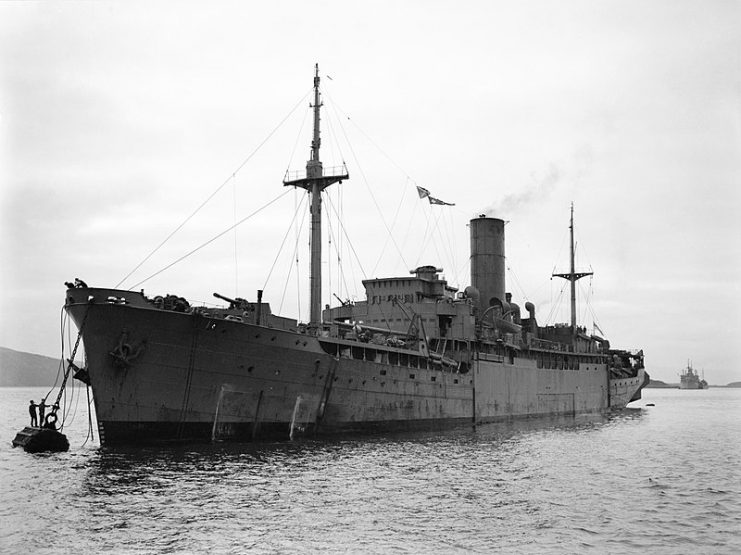 The auxiliary minelayer HMS AGAMEMNON, a former Blue Funnel Liner, moored at a minelaying base on the Kyle of Lochalsh.
The auxiliary minelayer HMS AGAMEMNON, a former Blue Funnel Liner, moored at a minelaying base on the Kyle of Lochalsh.
Having begun life as a cargo-passenger vessel in 1929, been requisitioned for minesweeping in 1939, then repurposed once more for auxiliary services in 1944, the ship’s motto multa tuli fecique, “I have borne much and done many things,” is an incontestable truth.
The Menestheus’ glorious career came to an unfortunate end in mid-April 1953 when an internal explosion caused a major fire. The crew was forced to abandon ship off the coast of Mexico. Luckily, no one went down with the ship save the memories of one of the most ingenious creations by the British army to date.
